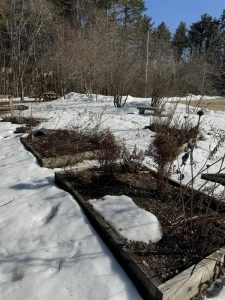(by Diane De Luca)
As the weather warms, it’s tempting to jump into spring garden cleanup. But before you grab your rake, consider how your actions impact pollinators and other insects. By delaying cleanup, adjusting your approach, and doing less overall, you can provide essential habitat and support biodiversity.

Timing Matters
You may have heard the advice to “leave the leaves” in the fall—but what about spring? The best approach is to wait until temperatures stay consistently above 50°F (10°C), or until apple and pear blossoms have faded. However, many insects continue developing in leaf litter throughout spring and summer, so leaving some plant material year-round provides the best habitat.
Why Leaves Matter
Leaves are more than garden debris—they provide essential shelter for pollinators and other beneficial insects. Many species of butterflies and moths overwinter in leaf litter, emerging at different times throughout the warmer months. For example, fritillary butterflies lay their eggs on dried leaves near violets. The caterpillars hatch, overwinter in the leaves, and feed on violets in spring. Removing these leaves disrupts their life cycle.
Bumblebee queens also rely on leaf litter for protection after emerging from their underground nests. On cool days, they use the leaves as protection from predators and harsh weather. Beyond pollinators, leaf litter supports a variety of insects – such as beetles, spiders, and worms – that play a vital role in enriching your garden’s ecosystem.
How to Clean Up Thoughtfully
Instead of removing all organic material, adopt a balanced approach:
- Move, Don’t Remove: Relocate thick or matted leaves to less visible areas like garden edges, under shrubs, or compost piles. Lighter leaves can remain in place.
- Fluff, Don’t Bag: Loosen dense leaf layers to allow light, rain, and emerging plants to penetrate.
- Tidy Selectively: Clear leaves only from high-visibility areas like garden borders and paths. Replace them with compost or mulch to maintain a neat appearance.
- Avoid using leaf blowers or shredders—these tools can disturb or harm insects sheltering in leaves.
Leave Stems for Bees
Instead of cutting back perennials to the ground, trim hollow or pithy stems to 12–15 inches. These provide nesting sites for solitary bees like small carpenter bees. Suitable stems include Joe Pye Weed, goldenrods, coneflowers, sunflowers, and raspberries.
Before removing stems, check carefully for signs of life. Some butterflies, like swallowtails, attach their chrysalides to plant stalks while they develop.
A Win-Win Approach
Leaving leaves and stems in your garden offers multiple benefits:
- Provide Vital Habitat: Protect pollinators and other beneficial insects year-round.
- Save Time and Money: Reduce yard waste and cut down on mulch costs.
- Promote Biodiversity: Support a healthier, more diverse ecosystem right in your backyard.
A gentler, more mindful cleanup not only helps your garden thrive but also gives pollinators the shelter they need to survive and flourish.
